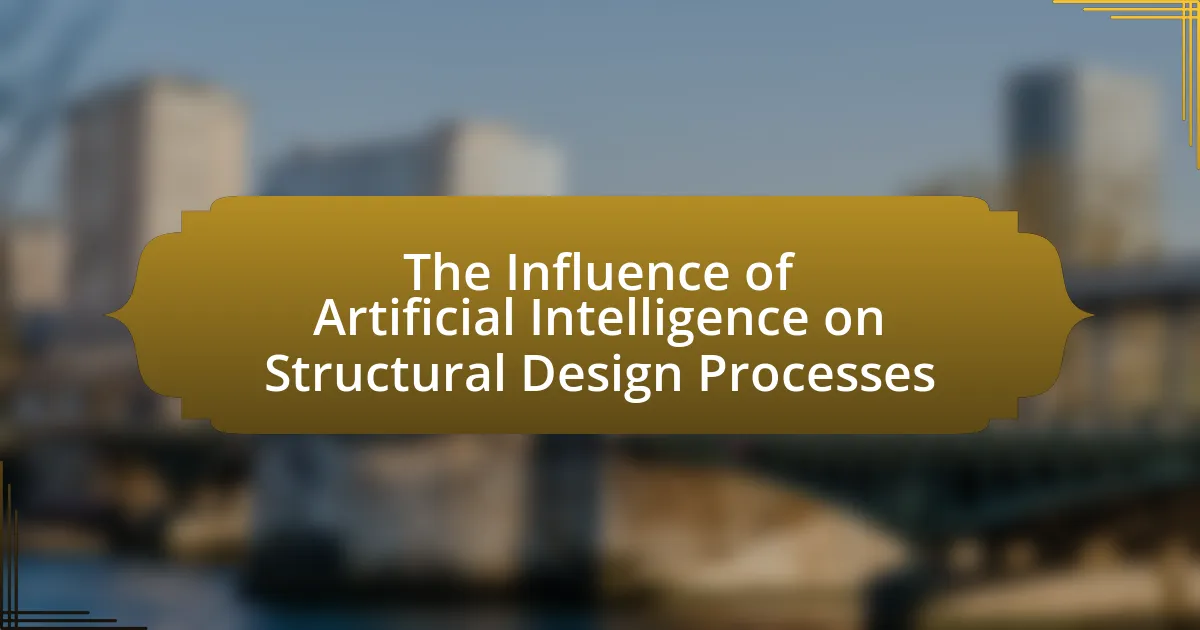The article examines the significant influence of Artificial Intelligence (AI) on structural design processes, highlighting its role in enhancing design efficiency, accuracy, and innovation. It discusses how AI integrates into structural design through technologies such as machine learning and generative design, leading to reduced material waste and improved decision-making. Key benefits include increased productivity, cost savings, and enhanced collaboration among design teams. The article also addresses challenges and ethical considerations associated with AI implementation, as well as future trends and necessary skills for professionals in the field.

What is the Influence of Artificial Intelligence on Structural Design Processes?
Artificial Intelligence significantly enhances structural design processes by optimizing design efficiency and accuracy. AI algorithms analyze vast datasets to identify patterns and generate innovative design solutions, reducing the time required for manual calculations and iterations. For instance, generative design software utilizes AI to explore multiple design alternatives based on specified parameters, leading to more efficient structures. Research by Autodesk demonstrates that projects using AI-driven design can reduce material waste by up to 30%, showcasing the tangible benefits of AI integration in structural engineering.
How does Artificial Intelligence integrate into structural design?
Artificial Intelligence integrates into structural design by utilizing algorithms and machine learning to optimize design processes, enhance efficiency, and improve safety. AI tools analyze vast datasets, enabling engineers to predict structural performance under various conditions, which leads to more informed decision-making. For instance, generative design software uses AI to explore numerous design alternatives based on specified constraints, significantly reducing the time required for the design phase. Additionally, AI-driven simulations can assess the impact of environmental factors on structures, ensuring compliance with safety standards. This integration is supported by studies showing that AI can reduce design time by up to 50% while increasing accuracy and innovation in structural solutions.
What technologies are involved in AI-driven structural design?
AI-driven structural design involves technologies such as machine learning, generative design, and building information modeling (BIM). Machine learning algorithms analyze vast datasets to predict structural performance and optimize designs, while generative design uses algorithms to explore numerous design alternatives based on specified constraints and goals. BIM integrates these technologies by providing a digital representation of physical and functional characteristics of structures, facilitating collaboration and efficiency in the design process. These technologies collectively enhance the accuracy, efficiency, and innovation in structural design, as evidenced by their increasing adoption in the architecture, engineering, and construction industries.
How does AI enhance the efficiency of design processes?
AI enhances the efficiency of design processes by automating repetitive tasks and providing data-driven insights. This automation allows designers to focus on more creative aspects of their work, significantly reducing the time required for project completion. For instance, AI algorithms can analyze vast amounts of data to identify optimal design parameters, leading to improved decision-making. A study by McKinsey & Company found that AI can increase productivity in design-related tasks by up to 30%, demonstrating its substantial impact on efficiency.
What are the key benefits of using AI in structural design?
The key benefits of using AI in structural design include enhanced efficiency, improved accuracy, and innovative design solutions. AI algorithms can analyze vast amounts of data quickly, allowing for faster design iterations and reducing the time required for project completion. For instance, AI-driven tools can optimize material usage and structural integrity, leading to cost savings and sustainability. Additionally, AI can identify potential design flaws early in the process, minimizing risks and ensuring compliance with safety standards. Studies have shown that projects utilizing AI in design phases can achieve up to 30% reduction in time and costs compared to traditional methods, demonstrating the significant impact of AI on structural design processes.
How does AI improve accuracy in structural analysis?
AI improves accuracy in structural analysis by utilizing advanced algorithms and machine learning techniques to analyze complex data sets more effectively than traditional methods. These AI systems can process vast amounts of information, including material properties, load conditions, and environmental factors, leading to more precise predictions of structural behavior. For instance, a study published in the Journal of Structural Engineering demonstrated that AI models could reduce error rates in structural assessments by up to 30% compared to conventional analysis methods. This enhanced accuracy results from AI’s ability to identify patterns and correlations within data that human analysts may overlook, thereby optimizing design decisions and improving overall structural integrity.
What cost savings can be achieved through AI in design?
AI in design can achieve cost savings by automating repetitive tasks, optimizing resource allocation, and reducing material waste. For instance, AI algorithms can analyze design parameters and suggest the most efficient materials and construction methods, leading to a reduction in overall project costs. A study by McKinsey & Company found that AI can reduce design time by up to 50%, which directly translates to lower labor costs. Additionally, AI-driven simulations can identify potential design flaws early in the process, minimizing costly revisions and delays.
What challenges arise from implementing AI in structural design?
Implementing AI in structural design presents several challenges, including data quality issues, integration with existing systems, and the need for skilled personnel. Data quality is critical, as AI algorithms require accurate and comprehensive datasets to function effectively; poor data can lead to flawed designs. Integration challenges arise when attempting to incorporate AI tools into traditional design workflows, which may not be compatible with new technologies. Additionally, there is a significant demand for professionals who possess both engineering expertise and AI knowledge, creating a skills gap in the industry. These challenges hinder the seamless adoption of AI in structural design processes.
What are the potential risks associated with AI in design processes?
The potential risks associated with AI in design processes include bias in decision-making, loss of human creativity, and over-reliance on automated systems. Bias can occur when AI algorithms are trained on unrepresentative data, leading to skewed design outcomes that may not meet diverse user needs. For instance, a study by the MIT Media Lab found that facial recognition systems had higher error rates for individuals with darker skin tones, highlighting the importance of diverse training data. Loss of human creativity can result from AI-generated designs that prioritize efficiency over innovation, potentially stifling unique ideas. Over-reliance on AI can lead to diminished critical thinking skills among designers, as they may become dependent on AI suggestions rather than developing their own solutions. These risks underscore the need for careful integration of AI in design processes to ensure balanced and equitable outcomes.
How can professionals address the skills gap in AI technologies?
Professionals can address the skills gap in AI technologies by implementing targeted training programs and fostering collaboration between academia and industry. These training programs should focus on practical applications of AI in structural design, equipping professionals with the necessary skills to utilize AI tools effectively. For instance, a report by the World Economic Forum highlights that 54% of all employees will require significant reskilling by 2022 to adapt to technological advancements, including AI. Additionally, partnerships with universities can facilitate research initiatives that align educational curricula with industry needs, ensuring that the workforce is prepared for the evolving demands of AI in structural design.
How does AI influence collaboration in structural design teams?
AI enhances collaboration in structural design teams by facilitating real-time communication and data sharing among team members. This technology enables seamless integration of various design tools, allowing architects, engineers, and contractors to work concurrently on projects. For instance, AI-driven platforms can analyze design options and provide instant feedback, which accelerates decision-making processes. Research from McKinsey indicates that teams using AI tools can improve productivity by up to 20%, demonstrating the significant impact of AI on collaborative efficiency in structural design.
What tools facilitate AI-driven collaboration among designers?
AI-driven collaboration among designers is facilitated by tools such as Figma, Adobe XD, and Miro. These platforms leverage AI features to enhance real-time collaboration, streamline design workflows, and improve communication among team members. For instance, Figma allows multiple users to work on a design simultaneously, while Adobe XD integrates AI for automating repetitive tasks, thus increasing efficiency. Miro provides a collaborative whiteboard experience that incorporates AI to suggest design elements and layouts based on user input, fostering creativity and innovation in design processes.
How does AI change communication dynamics in design projects?
AI transforms communication dynamics in design projects by facilitating real-time collaboration and enhancing clarity among team members. Through tools like AI-driven design software and chatbots, stakeholders can share ideas, receive instant feedback, and resolve issues more efficiently. For instance, a study by McKinsey & Company found that teams using AI tools can improve productivity by up to 25%, as these tools streamline communication and reduce misunderstandings. This shift leads to more cohesive project development and faster decision-making, ultimately resulting in higher-quality design outcomes.

What are the future trends of AI in structural design?
The future trends of AI in structural design include enhanced generative design, predictive analytics, and improved collaboration through AI-driven tools. Generative design utilizes algorithms to explore numerous design alternatives based on specified parameters, leading to optimized structures that meet performance and sustainability goals. Predictive analytics leverages historical data and machine learning to forecast structural performance and maintenance needs, thereby reducing costs and increasing safety. Furthermore, AI-driven collaboration tools facilitate real-time communication among stakeholders, streamlining the design process and improving project outcomes. These trends are supported by advancements in computational power and data availability, which enable more sophisticated AI applications in the field.
How is AI expected to evolve in the field of structural engineering?
AI is expected to evolve in the field of structural engineering by enhancing design efficiency, improving predictive maintenance, and enabling real-time monitoring of structures. Advanced algorithms will facilitate the optimization of structural designs through generative design techniques, allowing engineers to explore a wider range of design alternatives quickly. Additionally, AI-driven predictive analytics will help in assessing the health of structures by analyzing data from sensors, leading to timely maintenance and reduced risks of failure. Research indicates that the integration of AI in structural engineering can lead to cost savings of up to 30% in project delivery and maintenance (McKinsey & Company, 2021).
What emerging technologies are likely to impact AI in design?
Emerging technologies likely to impact AI in design include generative design, augmented reality (AR), and blockchain. Generative design utilizes algorithms to create optimized design solutions based on specified parameters, enhancing creativity and efficiency in the design process. Augmented reality allows designers to visualize and interact with their designs in real-time, improving collaboration and decision-making. Blockchain technology can provide secure and transparent tracking of design iterations and intellectual property, fostering trust and accountability in design projects. These technologies collectively enhance the capabilities of AI in design, leading to more innovative and efficient structural design processes.
How will regulatory frameworks adapt to AI advancements in design?
Regulatory frameworks will adapt to AI advancements in design by implementing updated guidelines that address the unique challenges posed by AI technologies. These adaptations will likely include the establishment of standards for transparency, accountability, and ethical use of AI in design processes. For instance, the European Union’s proposed AI Act aims to classify AI systems based on risk levels and impose stricter regulations on high-risk applications, which directly impacts design sectors utilizing AI. Additionally, regulatory bodies will likely collaborate with industry stakeholders to ensure that regulations keep pace with rapid technological advancements, thereby fostering innovation while safeguarding public interests.
What role does machine learning play in structural design?
Machine learning plays a crucial role in structural design by enabling predictive analytics and optimization of design processes. It allows engineers to analyze vast datasets, identify patterns, and make data-driven decisions that enhance structural performance and safety. For instance, machine learning algorithms can predict the behavior of materials under various conditions, leading to more efficient designs. Research published in the journal “Automation in Construction” by Zhang et al. (2020) demonstrates that machine learning techniques can reduce design time by up to 30% while improving accuracy in load predictions. This integration of machine learning into structural design not only streamlines workflows but also fosters innovation in material usage and structural integrity.
How does machine learning enhance predictive modeling in design?
Machine learning enhances predictive modeling in design by enabling the analysis of vast datasets to identify patterns and trends that inform design decisions. This capability allows designers to create more accurate models that predict performance outcomes based on historical data. For instance, a study by Zhang et al. (2020) demonstrated that machine learning algorithms could improve the accuracy of structural load predictions by up to 30% compared to traditional methods. By leveraging these advanced algorithms, designers can optimize materials, reduce costs, and enhance overall project efficiency, ultimately leading to more innovative and effective design solutions.
What are the implications of machine learning on design optimization?
Machine learning significantly enhances design optimization by enabling more efficient and effective decision-making processes. It allows for the analysis of vast datasets to identify patterns and relationships that inform design choices, leading to improved performance and reduced costs. For instance, in structural engineering, machine learning algorithms can predict the optimal material usage and structural configurations, resulting in designs that meet safety standards while minimizing waste. Research by Zhang et al. (2020) in the journal “Automation in Construction” demonstrates that machine learning techniques can reduce design time by up to 30% while increasing the accuracy of structural assessments. This integration of machine learning into design optimization not only streamlines workflows but also fosters innovation in structural design methodologies.
How can professionals prepare for the integration of AI in their design processes?
Professionals can prepare for the integration of AI in their design processes by acquiring relevant skills in AI technologies and understanding their applications in design. This includes learning programming languages such as Python, which is widely used in AI development, and familiarizing themselves with machine learning frameworks like TensorFlow or PyTorch. Additionally, professionals should engage in continuous education through online courses and workshops focused on AI in design, as this knowledge is crucial for leveraging AI tools effectively. Research indicates that companies that invest in AI training for their employees see a 20-30% increase in productivity, highlighting the importance of skill development in this area.
What skills should engineers develop to leverage AI effectively?
Engineers should develop skills in data analysis, machine learning, programming, and domain-specific knowledge to leverage AI effectively. Data analysis skills enable engineers to interpret and manipulate large datasets, which is crucial for training AI models. Machine learning knowledge allows engineers to understand algorithms and their applications in structural design. Proficiency in programming languages, such as Python or R, is essential for implementing AI solutions. Additionally, domain-specific knowledge in structural engineering ensures that AI applications are relevant and effective in addressing real-world challenges. These skills collectively enhance an engineer’s ability to integrate AI into structural design processes, leading to improved efficiency and innovation.
How can organizations foster a culture of innovation with AI?
Organizations can foster a culture of innovation with AI by integrating AI tools into their workflows to enhance creativity and efficiency. By leveraging AI for data analysis, organizations can uncover insights that drive innovative solutions, as evidenced by a McKinsey report which states that companies using AI in their operations can increase productivity by up to 40%. Additionally, promoting collaboration between AI systems and human teams encourages diverse perspectives, leading to more creative outcomes. Implementing training programs that educate employees on AI capabilities further empowers them to utilize these technologies effectively, fostering an environment where innovation can thrive.

What are the ethical considerations of using AI in structural design?
The ethical considerations of using AI in structural design include accountability, transparency, and bias. Accountability is crucial as it determines who is responsible for decisions made by AI systems, especially in safety-critical applications like structural design. Transparency is necessary to ensure that the algorithms and data used in AI systems are understandable and accessible, allowing stakeholders to evaluate their reliability and fairness. Bias in AI can lead to unequal treatment or outcomes, particularly if the training data reflects historical inequalities or lacks diversity. For instance, a study by the AI Now Institute highlights that biased algorithms can perpetuate existing disparities in urban planning and infrastructure development. These considerations are essential to ensure that AI enhances structural design without compromising ethical standards.
How does AI impact decision-making in structural design?
AI significantly enhances decision-making in structural design by providing data-driven insights and optimizing design processes. Through advanced algorithms and machine learning, AI analyzes vast amounts of data, including material properties, environmental conditions, and structural performance metrics, enabling engineers to make informed choices. For instance, AI tools can predict structural behavior under various loads and conditions, leading to safer and more efficient designs. Research by Autodesk highlights that AI-driven generative design can produce multiple design alternatives, allowing engineers to evaluate options based on performance criteria, cost, and sustainability. This capability not only accelerates the design process but also improves the overall quality of structural outcomes.
What ethical dilemmas arise from AI-driven design choices?
AI-driven design choices present ethical dilemmas such as bias, accountability, and transparency. Bias arises when algorithms reflect or amplify existing societal prejudices, leading to unfair outcomes in design applications. For instance, a study by ProPublica found that an AI system used in criminal justice disproportionately flagged African American individuals as high risk, highlighting the potential for discriminatory practices in AI-driven decisions. Accountability issues emerge when it is unclear who is responsible for the decisions made by AI systems, complicating liability in cases of failure or harm. Transparency is also a concern, as many AI algorithms operate as “black boxes,” making it difficult for designers and users to understand how decisions are made, which can undermine trust and ethical standards in design processes.
How can transparency be maintained in AI algorithms used in design?
Transparency in AI algorithms used in design can be maintained through the implementation of explainable AI (XAI) techniques. These techniques allow designers and stakeholders to understand how algorithms make decisions by providing insights into the data, processes, and reasoning behind outputs. For instance, using model-agnostic methods like LIME (Local Interpretable Model-agnostic Explanations) can help elucidate the contributions of various input features to the final design decisions. Furthermore, maintaining comprehensive documentation of the algorithm’s development, including data sources, training processes, and performance metrics, enhances accountability and trust. Studies have shown that organizations that prioritize transparency in AI systems experience increased user trust and satisfaction, as evidenced by research published in the Journal of Artificial Intelligence Research, which highlights the correlation between transparency and user acceptance in AI applications.
What best practices should be followed when implementing AI in structural design?
When implementing AI in structural design, best practices include ensuring data quality, integrating interdisciplinary collaboration, and maintaining regulatory compliance. High-quality data is essential for training AI models effectively, as inaccuracies can lead to flawed design outcomes. Interdisciplinary collaboration among engineers, architects, and data scientists fosters innovative solutions and enhances the AI’s applicability in real-world scenarios. Additionally, adhering to regulatory standards ensures that AI-driven designs meet safety and performance requirements, which is critical in the construction industry. These practices collectively enhance the reliability and effectiveness of AI in structural design.
How can teams ensure the reliability of AI-generated designs?
Teams can ensure the reliability of AI-generated designs by implementing rigorous validation processes and continuous monitoring. Validation involves comparing AI outputs against established design standards and benchmarks, ensuring that the generated designs meet safety, functionality, and aesthetic criteria. Continuous monitoring allows teams to assess the performance of AI-generated designs in real-world applications, identifying any discrepancies or failures early. Research indicates that incorporating human oversight in the design review process significantly enhances the reliability of AI outputs, as human experts can provide contextual insights that AI may overlook.
What strategies can be employed to evaluate AI tools in design processes?
To evaluate AI tools in design processes, organizations can employ strategies such as benchmarking against established design metrics, conducting user experience assessments, and performing cost-benefit analyses. Benchmarking involves comparing the performance of AI tools against industry standards or previous design outcomes to measure effectiveness. User experience assessments gather feedback from designers and stakeholders to evaluate usability and integration within existing workflows. Cost-benefit analyses quantify the financial implications of implementing AI tools, considering both initial investments and long-term savings. These strategies ensure that AI tools enhance design processes effectively and align with organizational goals.
What practical tips can enhance the use of AI in structural design processes?
To enhance the use of AI in structural design processes, integrating AI-driven generative design tools is essential. These tools allow engineers to explore a wide range of design alternatives quickly, optimizing for factors such as material efficiency and structural integrity. For instance, Autodesk’s generative design software has been shown to reduce material usage by up to 30% while maintaining performance standards. Additionally, incorporating machine learning algorithms can improve predictive analytics for structural performance, enabling proactive maintenance and reducing lifecycle costs. Research indicates that firms utilizing AI in design processes report increased productivity and innovation, demonstrating the tangible benefits of these technologies in structural engineering.

Leave a Reply